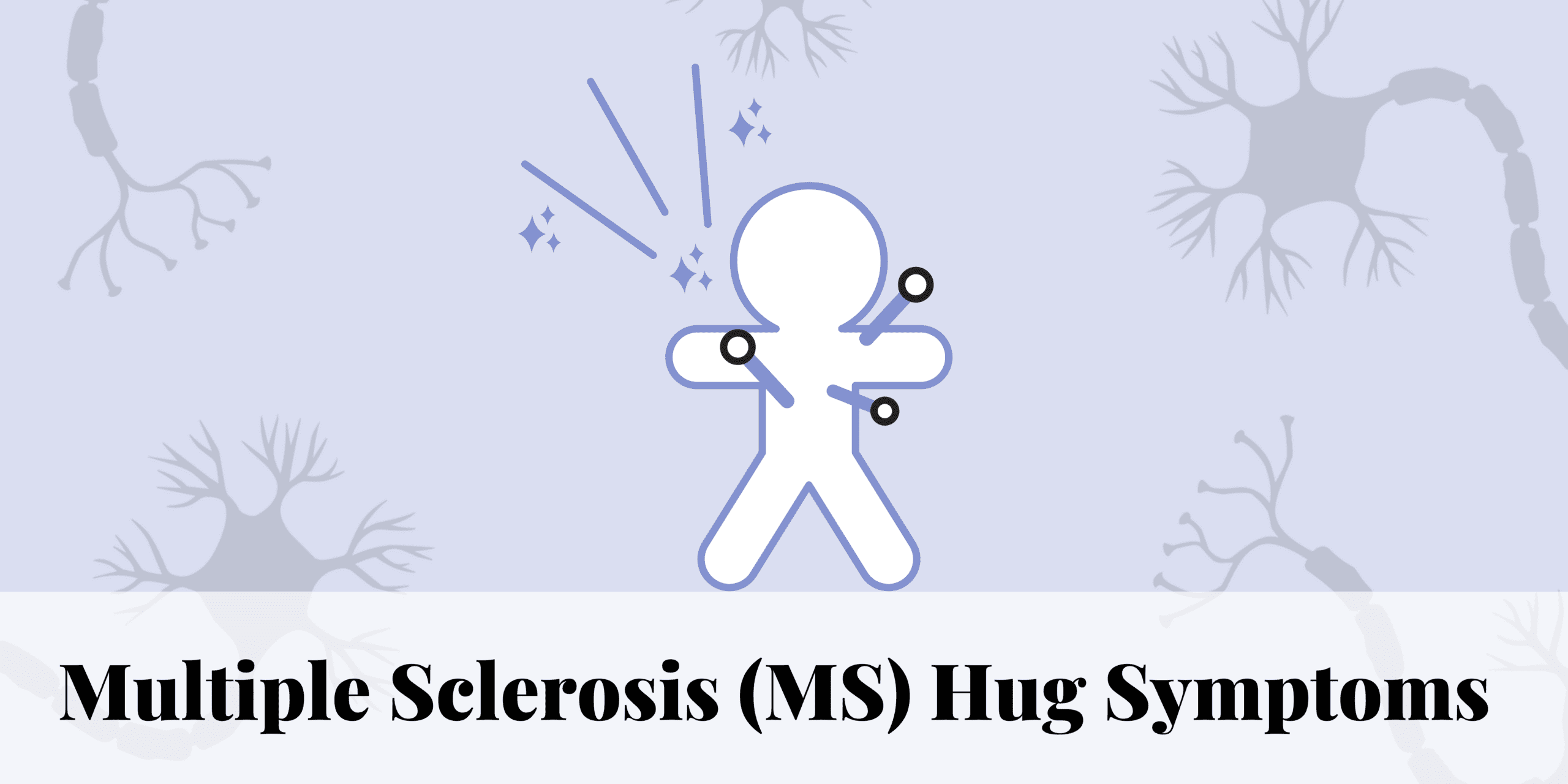
Let’s just jump right into it. Multiple Sclerosis (MS) hug symptoms occur because of muscle spasms in the intercostal muscles. The intercostal muscles are the muscles that line the spaces of the ribs and in turn, overall protect the ribcage (as it holds vital organs inside). It is called an “MS hug” because the tightness is a band-like sensation around the entire torso** (2,3).
**It is important to note that this sensation can be felt in other inflammatory conditions such as transverse myelitis or Costochondritis (2). These conditions will also create the same tightness sensation and should not be misdiagnosed as MS. Speaking to a licensed professional is indispensable in this case.
MS Hug Symptoms
During an episode of an “MS hug”, the following symptoms or sensations can be experienced:
- Burning (hot or cold) (2,3)
- Dull and achy pain (2)
- Difficulty breathing (2)
- Pain on one side of your body (2)
- Pressure/Squeezing/Crushing (2,3)
- Sharp pain (2)
- Tickling (2)
- Tightness (2)
- Tingling or pins and needles (2)
- Vibration (3)
- Crawling sensations under the skin (3)
Recording of MS Hug Symptoms
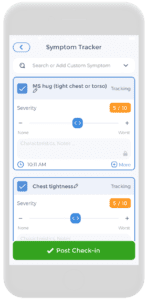
As noted before, the MS hug is a tight, uncomfortable, sometimes painful sensation that wraps around the body as if one is being squeezed. Hence why there are many other names describing an MS hug. It is also known to be called “Banding”, “Girdle-band”, “Girdling” or “MS girdle” (3). For your reference, refer to the symptoms above.
Regardless of which symptom one may experience, it is important to keep track of all of them in one convenient place. The CareClinic platform allows symptom tracking (as shown on the left). It even has a specific symptom search for MS hug. It even holds the capability to rate the severity as well as write personal notes. This symptom tracker will be essential in monitoring these symptoms, especially if new ones arise. These new symptoms can help guide prognosis, diagnosis, and treatment. This conversation will be crucial to have with the healthcare team.
Stay on track with all your healthcare needs (as well as with MS hug symptoms tracking or MS hug areas as listed below) in the one-stop-shop that is the CareClinic Platform.
MS Hug Areas
Not every MS patient will express the same MS hug areas. In fact, some people will report zero pain. Instead, they might feel pressure around their waist, torso, or neck. Others can experience a band of tingling or burning in the same area (3).
As with other symptoms, the MS hug is unpredictable, and each person will experience it differently. Some people also experience these symptoms in their hands, feet, and head instead. People with this type of sensation feel like they are wearing tight gloves or boots (2,3). Keeping track of these MS hug symptoms and MS hug areas is crucial in having an important discussion with the healthcare team to come up with the best treatment options (which will be discussed later).
Duration of MS Hug Symptoms
Symptoms will usually last from a few seconds to hours at a time. However, in some rare instances, one MS hug episode can last several days (2,3).
MS Hug Triggers
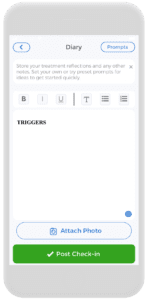
There may not be a particular “cause” that may be causing the MS hug triggers. However, there are some factors that have been noted to particularly trigger MS hugs.
The MS hug often responds to the same triggers as other MS symptoms. It might show up, or get worse if you are: Fighting a cold, flu, bladder infection, fatigued, stressed out, or in higher heat temperatures. Furthermore, one particular symptom of MS is dysesthesia which is defined as an unusual tingling sensation caused by nerve trauma. Dysesthesia could also be causing the MS hug (2,3).
It is extremely important to keep notes on such MS hug triggers and try to catch what is setting it off in the first place. Part of managing pain is knowing what causes or triggers it. By using the Diary function in the CareClinic platform (picture illustrated on the right), these triggers can be noted daily. In your own words!
Talking to the healthcare team will be a breeze with daily log entries on the CareClinic platform. Knowing these triggers and discussing them openly with the team will be crucial to getting the help you have been praying for. Utilize the CareClinic platform today and be one step closer to health freedom.
MS Hug Treatment
Not everyone will need medications to help treat MS hug. Sometimes, figuring out the MS hug triggers and pure avoidance can be enough. However, pain is subjective and some may need medications to help with pain relief. Which category of medication will be preferred will be the discussion that will occur with the physician.
Nerve Pain Medications
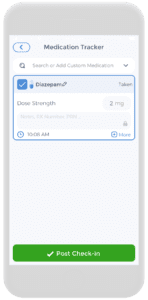
Although the MS hug is technically the result of a muscle spasm, the pain is actually neurologic in nature (since MS is a neurological disorder). The underlying pathology lies in the damage to the nervous system. In other words, it is nerve pain, not muscle pain.
Originally, many of the drugs used to treat nerve pain were approved for other conditions. The exact way they work against nerve pain is not extremely clear. However, the drug classes approved to treat the nerve pain of the MS hug are:
- Antispasticity medications (i.e. diazepam- illustrated in the picture on the left at the lowest dose of 2mg) (2,3)
- Anticonvulsant medications (i.e gabapentin) (2,3)
- Antidepressant medications (i.e amitriptyline) (2,3)
- Diabetic medications used “off-label” for MS (i.e. hydrochloride or pregabalin)
The CareClinic platform has a medication tracker for all of your medication needs. It allows the recording of all medications as well as refill reminders etc. Begin the journey by downloading today.
Steroid Medications
If the healthcare team believes or thinks the symptoms are signalled from a relapse of MS, steroids might be prescribed to help prevent the MS relapse overall. Some medications that are used for MS are:
- Corticotropin (Acthar, HP Acthar) (3)
- Methylprednisone (3)
- Prednisone (3)
Long-term steroid usage is not recommended. There are also a lot of side effects with short-term or prolonged steroid use. Furthermore, steroids cannot be abruptly stopped. It is fundamental to speak to your doctor today about which medication option is right for you.
Muscle Relaxers
As mentioned before, MS hug symptoms are most likely due to nerve pain and not necessarily muscle. However, despite this, a mix of treatments can be added to help symptoms. Some physicians will prescribe medications that work to relax the muscle such as:
- Muscle relaxers like baclofen (Lioresal, Gablofen) (3)
Again, speaking to the healthcare team will be essential.
Over-the-Counter Medications
Some physicians may also include over-the-counter medications such as:
- Acetaminophen or ibuprofen (3)
- Pain relief cream (3)
These may not provide much relief but can be critical to some in pain management. Speak to the healthcare team for this important discussion.
MS Hug Prevention
Although there is no particular medication(s) that can completely prevent MS hugs symptoms from occurring…however, the triggers should be learned to be avoided for long-term relief.
MS hugs can be prevented or minimized by:
- Resting more (2)
- Cooling off (2)
- Treating a fever that is increasing body temperature (2)
- Finding ways to de-stress (2)
Managing MS Hug Symptoms
Generally speaking, simple things that can be done at home or in local places can help with MS as well as MS hug. Some examples are listed here:
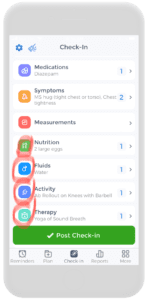
- Apply a warm compress. (Be careful with this one as heat might make the pain worse.) (3)
- Drinking plenty of water (3)
- Eating healthier food options/alternatives (3)
- Getting a massage (3)
- Stay rested. Getting at least 8 hours of sleep each night (3)
- Using deep breathing techniques, attending yoga classes, and incorporating meditation (3)
- Some people get relief from wearing tight clothing but may prefer loose clothing (3)
All of these examples above can be recorded in one convenient platform! The main Check-In page in the CareClinic platform has a variety of options for recording nutrition intake, fluid intake, sleep, activities (i.e. yoga, meditation, etc.), and even therapy (i.e. deep breathing, etc).
Utilizing the CareClinic platform just became easier to record all of your healthcare needs and to help you excel with the management of all of your MS hug symptoms and MS in general.
Living with MS Hug
Trying the suggested lifestyle adjustments listed above and home remedies with medical treatment can help you stay comfortable during any MS hug episode. Managing unpredictable MS symptoms can affect everyday life and can be both difficult and frustrating. Although the MS hug is not considered a “life-threatening symptom”, it can still be uncomfortable and can limit mobility and independence. Which in turn, will affect the quality of life (2).
The home-run message is to do what makes you feel better. You know your body the best. Listen to it. So if it feels better when lightweight, loose clothing is worn, then please proceed. Or during an episode, if applying pressure to an area with the flat of your hand or wrapping the body with an elastic bandage helps, please proceed. The reason why this may provide relief is that this may help the nervous system “translate the feelings of pain or burning into pain-free pressure”, which may provide relief (2).
Relaxation techniques like deep breathing and meditation can sometimes ease discomfort during an episode. Some people with MS find that warm compresses or a warm bath help with MS hug symptoms. Heat makes the symptoms worse in other people, so it may take some trial and error to find what works for you. Learning to live with MS hug will be a process of trial and error. Keep track of the coping strategies that work for you(2), especially made easier with the CareClinic platform!
MS Hug Symptoms and Mental Well-Being
Mental health is important. Not only does your physical body matter but so does what goes on in your mind. Do not be afraid to reach out to your healthcare team if MS hug symptoms make you feel discouraged or depressed. Support groups or even finding organizations such as the MS Foundation (where you can connect with other people with MS) can help people with MS manage day-to-day life with their symptoms and maintain their mental well-being (2).
Unusual Symptoms of MS
Some symptoms are very diagnostic of MS. The diagnosis of MS is through clinical assessment and is supported by investigations. However, there is no single accurate and reliable diagnostic test for MS. There are characteristic clinical presentations based on the areas of the central nervous system (CNS) involved, for example, the optic nerve, brainstem, and spinal cord (1).
Interestingly, one of the unusual symptoms of MS is the MS hug. However, there are several more that are worth mentioning below.
Out of Control Laughing or Sobbing
This is caused by something called the “Pseudobulbar affect”, also called PBA or emotional incontinence. It prompts random outbursts of tears or laughter that have nothing to do with actual feelings. Nerve damage in the part of the brain that controls emotions can cause these responses to get all mixed up. This might be worrisome, especially about it happening when you are in public, or in a serious setting. Luckily, the FDA has approved a drug to treat PBA. Antidepressants can help, too (4). Speak to your physician regarding any medications.
“An Itch You Cannot Scratch”
“A sudden, intense tingle crops up out of the blue, anywhere on the body”. Interestingly, there are no actual skin irritation or allergy, or areas to apply rash cream. This kind of itch does not occur from underlying skin issues. It is called “Dysesthetic itching” and it is a nerve-related sensation. Thankfully, this “itch” passes quickly (4).
It is treatable with medication originally prescribed for epilepsy. Just to list a few:
- Carbamazepine (Carbatrol, Epitol, Equetro, Tegretol, Tegretol-XR) (4)
- Gabapentin (Gralise, Horizant, Neurontin) (4)
- Phenytoin (Dilantin, Phenytek) (4)
Again, please speak to your doctor about any medication usage.
Shocking Face Flashes
Nerve damage caused by MS can trigger a phenomenon called “trigeminal neuralgia”. It is described as a burning, stabbing, or shock-like pain in the cheek or jaw. However, it might fade fast or linger for a few minutes. Although it is rare, it can be the first symptom of MS. It might feel like a tingle, numbness, or ache on one side of the face, similar to dental pain (4).
Anticonvulsant meds such as carbamazepine, lamotrigine (Lamictal), or oxcarbazepine (Oxteller XR, Trileptal) can help (4). Speak to the healthcare professionals before any medication usage.
Difficulty Swallowing
Something so simple as swallowing can be easily taken for granted. However, for someone suffering from MS- a simple task can become very difficult. The nerves and muscles in the mouth and throat must work in conjunction with the brain. With MS, the muscles needed can weaken. All the mixed-up nerve signals and sensory distortions can make it hard to chew or control the food or liquid in the mouth. Or it can feel as if there is something stuck in the throat when there is not (4).
Lhermitte’s Sign
Lhermitte’s sign is a sudden “electric” zap that shoots down the spine and legs. Usually, it happens when the neck is flexed forward, as occurs when hair gets trimmed. (Another name for it is the “barber chair sign”) MS lesions in the cervical spine — the neck area — cause this sign. Lhermitte’s will go away as quickly as it occurs, therefore, it typically does not require treatment (4).
Optic Neuritis/Uhthoff’s Phenomenon
Damage to the optic nerve is very common and characteristic of MS. The optic nerve is the nerve supply to the eyes. Optic neuritis is caused by this damage to this particular nerve in MS. Surprisingly, this optic neuritis causes something called the Uhthoff’s phenomenon. This means the vision will briefly go blurry when the body temp rises. (The other MS symptoms may get worse, too.)(4)
It can help to take a cool shower, use a gel pack, and drink lots of cold water before exercising or going out in the heat (4).
Pulfrich Phenomenon
Another optical trick MS can play with the eyes is called the Pulfrich phenomenon. Again, optic neuritis triggers this. “It is a 3-D illusion caused by a conflict in vision”. For example, an object is headed toward you in a straight line. Instead, you might see its path as a spiraling ball. Or an oncoming car might appear to swerve toward you (4).
A special filter in front of one eye can help balance the vision and requires a specialist physician (4).
Paroxysms
Paroxysms are defined as abrupt, brief spasms that happen when electrical discharges fire in damaged areas of the brain. They might cause surges throughout the arm or leg, or the muscles used for eating and speaking. Although it can occur several to many times a day, paroxysms usually end within a few months. Despite the scary sensation, these are not the same thing as seizures.
They can be treated with antiepileptic meds, such as carbamazepine, lamotrigine, or oxcarbazepine (4).
Migraines
Migraines are sudden headaches that may last several hours to days. Often, they can sometimes be the first MS symptom. People with MS are twice as likely to have them. They can be debilitating as they can bring on nausea or make you sensitive to sound and light, restricting regular activities (4).
Hearing Problems
This is extremely rare. However, some have seen hearing problems in MS. It might be correlated to swelling and scar tissue near the auditory nerve, which carries information to the brain from the ear (and vice versa). Plaque buildup on the nerves along this pathway can lead to it, too. These episodes generally improve, and permanent deafness is extremely rare (4).
Vertigo
Vertigo makes the room feel like it is spinning. It can throw off-balance way more as well as cause dizziness. Also, you might feel lightheaded or nauseous from the sense of motion. It happens to about one in five people with MS. It can stem from damage in the same pathways that control the hearing and vision (as explained above) (4).
Treatment can include physiotherapy, which studies how your movements affect it (4).
MS Hug Symptoms: Final Takeaway
A lot of management and living with MS and its associated symptoms such as the MS hug requires a lot of trial and error. Unfortunate but reality. It will become difficult to manage without having a platform that can help you tackle all of your needs. Start using the CareClinic platform for all of your MS needs including tracking your MS Hug symptoms, MS hug triggers and all of its associated hug areas and so much more. Begin your journey today by downloading the platform using your iOS or Android devices by clicking below.
References
- Ford H. (2020). Clinical presentation and diagnosis of multiple sclerosis. Clinical medicine (London, England), 20(4), 380–383. https://doi.org/10.7861/clinmed.2020-0292
- Healthline. (2022, January 18). The MS hug: What is it? How is it treated? https://www.healthline.com/health/multiple-sclerosis/ms-hug#takeaway
- WebMD. (2020, April 14). What is the MS Hug? https://www.webmd.com/multiple-sclerosis/ms-hug-how-ease-pain
- WedMD. (2021, March 7). Unusual Symptoms of MS. https://www.webmd.com/multiple-sclerosis/ss/slideshow-unusual-symptoms-ms


